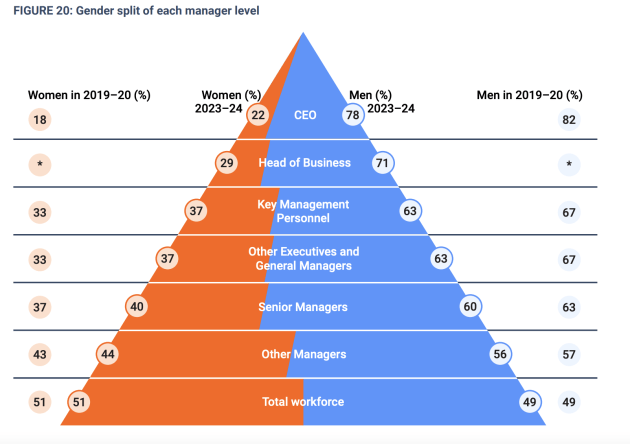According to Australia’s 2023-24 Gender Equality Scorecard, there is still a “sizeable and pervasive” total remuneration gender pay gap of almost 22 per cent. The Workplace Gender Equality Agency (WGEA) research shows that while the food and beverage manufacturing industry has started reducing this gap on paper, the uneven composition of its workforce has an impact.
The information and data in the 2023-24 scorecard is based on gender equality reports from 7414 employers, which reported to WGEA by 31 August. This is up from 4962 reporting employers for the Employer Gender Pay Gaps Snapshot released in February.
The total remuneration gender pay gap has dropped by 0.6 percentage points to 21.1 per cent, when compared to last year. This year included CEO and Head of Business data for the first time, which increased the figure marginally, to 21.8 per cent.
Women earn, on average, 78 cents for every dollar men earn, equating to $28,425 less each year. Half of employers have an average total remuneration gender pay gap over 12.1 per cent and a median gender pay gap over 8.9 per cent (decreased from 9.1 per cent last year).
Food and beverage manufacturing has larger gender pay gaps than both the national average and median across industries. This is expected in male-dominated industries, but the WGEA Scorecard notes that average remuneration of women and men in gender-balanced industries still often favours men.
Both workforces are strongly male-dominated, made up of almost two-thirds men, and the breakdown by occupation and employment type are also indicative of this.
The scorecard shows having a balance of genders in a workforce is insufficient for workplace gender equality, and occupational segregation within gender-balanced industries can perpetuate the gender pay gap.
Food product manufacturing

The overall composition of the food manufacturing workforce is 35 per cent women, and 65 per cent men. Manufacturing, including food production, is a strongly male-dominated industry, in which women composed a higher proportion of the workforce in only clerical and administration (70 per cent), community and personal service (60 per cent), and sales (56 per cent) roles.
Men occupied an overwhelming 87 per cent of CEO and technician/trade roles, as well as 80 per cent of head of business positions.
Interesting to note was employment status – although full time roles were occupied by only 32 per cent women, part-time roles almost doubled that statistic to 62 per cent.
Average total remuneration gender pay gap across food product manufacturing was at 14 per cent, with median total remuneration at 9.2 per cent, down from 12.5 per cent last year. These are both higher than the average across all industries, but the three per cent reduction shows promise.
A strong 88 per cent of organisations had a formal policy/strategy in place to support gender equality in the workplace, as well.
Beverage and tobacco product manufacturing

The outlook for beverage manufacturing is similar to food, with an overall workforce composition of 35 per cent women and 65 per cent men.
Women composed a higher proportion of the workforce in only clerical and administration (69 per cent), and community and personal service (60 per cent). Men occupied an overwhelming 90 per cent of CEO, 83 per cent machinery operators/drivers, and 82 per cent technician/trade roles, but a much more modest 58 per cent of head of business positions.
In terms of employment status, full time roles were only occupied by 30 per cent women, while part-time roles were occupied by a whopping 85 per cent.
Average total remuneration was at 13.3 per cent, with median total remuneration at a more reasonable 9 per cent, dropping from 13 per cent last year, and 86 per cent of organisations had a formal policy/strategy in place to support gender equality in the workplace.
It’s not all bad – right?
Overall, a majority of employers (56.4 per cent) and the majority in every industry improved their average total remuneration gender pay gap over the last year, including in food and beverage manufacturing.
The proportion of employers conducting a gender pay gap analysis increased 13 percentage points to 68 per cent. Of those, 90 per cent did the analysis in the past 12 months and the proportion taking action on the results increased 15 percentage points to 75 per cent.
More employers have a gender equality policy and consulted their employees, and almost half of all employers (45 per cent) are setting targets.
Although there is slow progress being made, 100 per cent of occupations and industries still have a gender pay gap in favour of men, strongly driven by the lack of women appointed to higher-paying management roles, as well as the discrepancies within these occupations.

This year included CEO and head of business data, showing a meagre 22 per cent are women, and the gender pay gap for these key roles is the highest of all managers – at 27.1 per cent. On average, women CEO/HOBs are paid $158,632 less in total remuneration than men. A quarter of company boards still have no women, and in male-dominated industries this goes up to 41 per cent.
Tellingly, 30 per cent of women work part-time, but only 7 per cent of manager roles are part-time.
WGEA stated that the Scorecard points to areas for employer action, progress, and positive change.
“The Scorecard can serve as a comparison for an employer with their organisation’s or industry’s data to understand how their progress may differ or align with national trends in order to make a data-informed assessment on where they are stuck and what can be done about it,” it stated.
“Employers can use the data in this Scorecard to begin the hard work, take more effective and ambitious action, and make workplace gender equality a priority.”
It falls to employers to push harder for workplace equality, as Australia pushes for systemic change.







